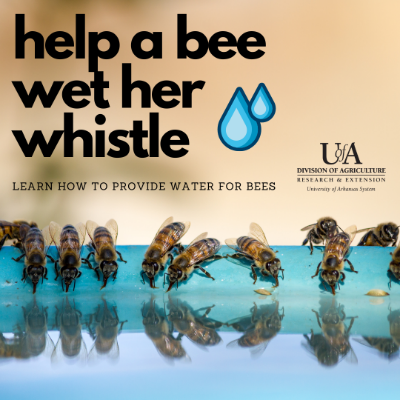UA Bee Blog

Help a Bee to Wet Her Whistle
All creatures need water -- and bees are no exceptions! Bees may be able to get sufficient
water from the nectar they drink to get by, but they are often found drinking water
from other sources in the summer. Honey bees particularly need extra water because
they use it to cool their hives in the summer time. 

Honey bee colonies can get hot!
A honey bee colony could have over 40,000 members by the middle of the summer. Even
though they aer each very small, all those bodies can produce a lot of heat. Honey
bees maintain a fairly constant temperature of 93 degrees inside their nest, which
is the perfect temperature to incubate baby bees. They can warm things up when the
weather is cold, but they also need to cool things off when the weather gets hot.
How do honey bees cool off?
Honey bees are remarkable creatures that have learned to ventilate their homes. Many
bees will line up together, facing one direction, and actively fan their wings, creating
air currents into and out of a bee hive. They bring in fresh, cool, oxygen-rich air,
while blowing out the stale, humid air filled with carbon dioxide. When our temperatures are hotter than the ideal nest temperature, however, just bringing
in outside air doesn't help as much. They bees then rely on evaporative cooling.
You might notice honey bees lining up for a drink at a puddle, a creek, a bird bath,
or even near a swimming pool. They fill their nectar crops with water (this is the
same extra "stomach" they use to transport nectar back home from the flowers they
visit). Back at the hive, the busy bees will deposit tiny droplets of water all around
the hive. Now, as the bees fan their wings, the moving air evaporates the water,
and carries some of the heat away with it. They use the same activity to evaporate
water from nectar to help turn it into honey.
You might feel a little cooler when you climb out of a pool, as the breeze draws off
some of the water and makes your skin feels cooler. Before refrigerated air conditioning
was popular, people relied on evaporative coolers -- also known as swamp coolers --
to help make homes more comfortable. This technology goes back to the ancient Egyptians,
who are believed to have hung wet blankets across windows to help cool the breezes
coming into a room. But honey bees should really get the credit for coming up the
idea first.
How can you provide water for bees?
Want to treat the bees in your neighborhood with some fresh cool water? You can leave
a dish out for them, or keep your bird bath full if you don't mind them buzzing around
your garden. Bees can't swim, though, and they can't sip while on the wing like a
hummingbird. Bees must land in order to take a drink, which is why you will observe
them lined up at the edge of a water source. You can fill a container with clean
gravel they can sit on while they sip, or provide them with pieces of wood floating
in the water for them to land on. Bees will also visit swimming pools and hot tubs
if they can't find any other water sources. They will usually be found sipping from puddles splashed around the pool, and won't
try to get to climb down the ladder. So be mindful of them as you walk around in
your bare feet.
Bees are always on the lookout for a sweet treat.
These bees are out on an important mission to collect water for their colony. They
don't have any interest in stinging people, but if they feel threatened, they might
react defensively. Also, be mindful of sweet foods and drinks outside in the summer.
Bees and other insects might be enticed by the smell and flavor of your soda pop,
candy, and sliced watermelons. Cover food and drinks to keep any insects out, and
don't swat at a bee that may just be looking around.
If you want to provide bees with water, you'll need to keep it consistently topped off.
If the water source dries up, they will find another one. Beekeepers should provide
their bees with water nearby, so they don't have to exert as much energy gathering
fresh water, and to keep them from having to find it where they may not be so welcome.
Hot summer weather also means wildflowers become more scarce. Plant things that will
bloom in July and August, when there may be little other forage available, and keep
those gardens watered too!